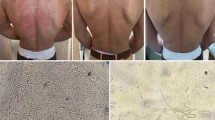Abstract
Objective: The aim of this multicentre, double-blind, vehicle-controlled study was to investigate the safety and efficacy of once-daily topical application of sertaconazole 2% cream compared with corresponding vehicle cream in the treatment of patients with tinea of glabrous skin.
Patients and methods: A total of 400 patients were recruited at seven investigational sites; 144 patients in the intent-to-treat (ITT) population and 127 in the per-protocol (PP) population were treated for 3 weeks with either sertaconazole 2% once daily or corresponding vehicle cream. To evaluate therapeutic efficacy and safety, microscopic examination of native preparations, mycological cultures, and clinical assessment of the state of the lesion (objective and subjective monitoring of symptoms) were analysed after 3 weeks of treatment.
Results: Based on these parameters, in both the PP and ITT populations, sertaconazole cream 2% once daily induced a higher cure rate than the vehicle cream: 82% of the PP population (vehicle cream control 61%; p = 0.014) and 83% of the ITT population (vehicle cream control 59%; p = 0.003) randomised to sertaconazole with a previously positive mycological culture showed negative culture results after sertaconazole treatment. No statistically significant differences were observed regarding frequency and severity of adverse effects.
Conclusion: These data indicate that treatment of superficial dermatomycoses with sertaconazole 2% cream for 3 weeks is efficient and safe. The once-daily application regimen may improve patient compliance, which has been shown to be of exceptional importance for successful treatment of dermatomycoses of the glabrous skin.





Similar content being viewed by others
References
Bastert J, Korting HC. Tinea in glabrous skin: total quality management. Z Arztl Fortbild Qualitatssich 1998; 92: 181–6
Noble SL, Forbes RC, Stamm PL. Diagnosis and management of common tinea infections. Am Fam Physician 1998; 58: 163–74
Palacin C, Sacristan A, Ortiz JA. In vitro activity of sertaconazole. Arzneimittelforschung 1992; 42: 689–774
Torres J, Marquez M, Camps F. Sertaconazole in the treatment of mycoses: from dermatology to gynecology. Int J Gynaecol Obstet 2000; 71: 3–20
Nasarre J, Umbert P, Herrero E, et al. Therapeutic efficacy and safety of the new antimycotic sertaconazole in the treatment of pityriasis versicolor. Arzneimittelforschung 1992; 42: 764–7
Umbert P, Nasarre J, Bello A, et al. Phase II study of the therapeutic efficacy and safety of the new antimycotic sertaconazole in the treatment of superficial mycoses caused by Candida albicans. Arzneimittelforschung 1992; 42: 757–60
Pedragosa R, Gonzales B, Martin M, et al. Therapeutic efficacy and safety of the new sertaconazole in the treatment of cutaneous dermatophytoses. Arzneimittelforschung 1992; 42: 760–3
Alomar C, Bassas S, Casas M, et al. Multicentre double-blind trial on the efficacy and safety of sertaconazole cream 2% in comparison with miconazole 2% cream on the patients suffering from cutaneous mycoses. Arzneimittelforschung 1992; 42: 767–73
Meinhof W, Girardi RM, Stracke A. Patient noncompliance in dermatomycosis: results of a survey among dermatologists and general practitioners and patients. Dermatologica 1984; 169 Suppl. 1: 57–66
Korting HC. Comparative efficacy and tolerability of econazole liposomal gel 1%, conventional cream 1% and generic clotrimazole cream 1% in tinea pedis. Clin Drug Invest 1997; 14: 286–93
DelPalacio A, Cuetara S, Perez A, et al. Topical treatment of dermatophytosis and cutaneous candidosis with flutrimazole 1% cream: double-blind, randomized comparative trial with ketoconazole 2% cream. Mycoses 1999; 42: 649–55
Evans EG, Seaman RA, James IG. Short-duration therapy with terbinafine 1% cream in dermatophyte skin infections. Br J Dermatol 1994; 130: 83–7
Evans EG, Dodman B, Williamson DM, et al. Comparison of terbinafine and clotrimazole in treating tinea pedis. BMJ 1993; 307: 645–7
Korting HC, Tietz HJ, Brautigam M, et al. One week terbinafine 1% cream (Lamisil) once daily is effective in the treatment of interdigital tinea pedis: a vehicle controlled study. LAS-INT-06 Study Group. Med Mycol 2001; 39: 335–40
Farre M, Ugena JM, Marquez M, et al. Pharmacokinetics and tolerance of sertaconazole in man after repeated percutaneous administration. Arzneimittelforschung 1992; 42: 752–4
Romaguera C, Herrero E, Marquez M, et al. Study on the sensitizing capacity of the new antimycotic sertaconazole in the treatment of cutaneous mycoses. Arzneimittelforschung 1992; 42: 754–6
Acknowledgements
We would like to thank Mrs Susanne Seebeck for her assistance in preparation of this manuscript and Dr Martin Eckert for expert statistical analysis. The study has been funded by Trommsdorff Arzneimittel GmbH, Alsdorf, Germany. The authors have provided no information on conflicts of interest directly relevant to the content of this study.
Members of the Sertaconazole Study Group (all from Germany): Dr M.B. Hornstein, Düsseldorf; Dr W. Klövekorn, Gilching; Dr G. Ludwig, Rheine; Dr C.W. Meisel, Nuremberg; Dr D. Selzle, Munich; Dr H.J. Karge, Munich; Dr W. Gudat, Bodenmais; Dr W. Steinborn, Bodenmais; Dr K. Fritz, Landau; Dr J. Gruber, Gundelfingen.
Author information
Authors and Affiliations
Corresponding author
Rights and permissions
About this article
Cite this article
Susilo, R., Korting, H.C. & Strauss, U.P. Dermatomycoses of the Glabrous Skin. Clin. Drug Investig. 23, 387–394 (2003). https://doi.org/10.2165/00044011-200323060-00002
Published:
Issue Date:
DOI: https://doi.org/10.2165/00044011-200323060-00002




